

Considering that the original proof of the double bubble conjecture in R3 took some twelve years to develop, producing a new and simpler proof of this result was a sizable achievement which we plan to soon submit for publication in a peer-reviewed journal. This proof combined the principles found in my previous proof of the double bubble conjecture in the plane and the specialized differential form approach to metacalibrations developed in the first sub-problem. Using this approach, I also completed the next step: generalizing our proof of the double bubble conjecture to higher dimensions. These differential forms (a generalization of vector field integration) are defined in such a way that allows us to compare competitor figures directly by using Stoke’s theorem to prove the necessary inequalities. This was done using specialized differential forms to generalize our previous two-dimensional results into arbitrary dimension. The first was developing a new way to overcome the problems of developing metacalibrations for problems in three or more dimensions. So far, I have tackled and solved the first two of these problems.
Soap bubble problem calculus of variations series#
My project set out to tackle the triple bubble conjecture as a series of sub-problems. These results have been subsequently generalized to show boundary minimization of the n-sphere and to prove the planar double bubble conjecture.


Metacalibrations were first used to give a simple new proof of the planar isoperimetric inequality. This shift in application allows metacalibration to handle a wider range of problems, including the fixed area or volume conditions of multiple bubble problems. Metacalibration is a new approach to calibration proof that overcomes these limitations. While calibration techniques have proven very successful in fixed boundary problems, their applicability to fixed volume constraints has previously been limited. Metacalibration is a generalization of previously used calibration techniques and was developed at BYU by my adviser, Dr. In my research I further developed a new method of proof called metacalibration in order to tackle the as-yet-unproven triple bubble conjecture. With no special symmetry, the triple bubble conjecture appears to be exceedingly difficult, if not impossible, to prove using this method. The triple bubble conjecture in space remains unproven. The final proof relied largely on the fact that the area-minimizing figure must be a surface of revolution. Schwarz first proved in 1884 that the sphere was surface area minimizing for figures that enclose a fixed volume, but was not until 2002 that Frank Morgan and others proved the double bubble conjecture in R3. The three-dimensional analogs of these multiple bubble problems have proven even more difficult to solve. This complexity proves to be a significant barrier to further results. For example, Wichiramala’s dissertation had to consider fifty-four possible configurations in order to prove minimization of the standard triple bubble. Unfortunately, this approach is marred by an ever-increasing combinatorial complexity.

This method was also employed by Wacharin Wichiramala, whose doctoral dissertation proves the corresponding result for three separated areas. Using this result, students of the 1990 SMALL group under Frank Morgan proved that the so-called “standard double bubble” was perimeter-minimizing among all figures separately enclosing two fixed areas. This reduced the argument to listing all combinatorial types meeting these requirements. Some advancements in planar multiple bubble problems were made by Frank Morgan, who showed that perimeter-minimizing figures consist of circular arcs meeting at vertices of degree three, forming 120° angles. The traditional approach has been to use calculus of variations to isolate properties of the area-minimizing figure and compare all possible figures of this type. Unfortunately, this has been proven only in some few cases. It is conjectured that the minimizer is the standard shape that soap bubbles form when clumped together. Over the past few decades, mathematicians have become increasingly interested in “multiple bubble problems.” These problems ask which figure among all those that separately contain a given number of volumes has the least surface area. My project was to further develop the technique of metacalibration, a new method of minimization proof, in order to prove the triple bubble conjecture: that the standard triple bubble is the least surface area way to separately enclose three given volumes. Gary Lawlor, Mathematics Education Goal/Purpose


 0 kommentar(er)
0 kommentar(er)
